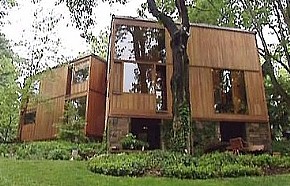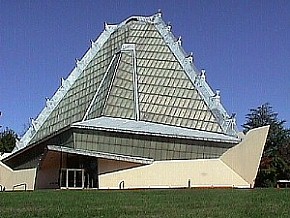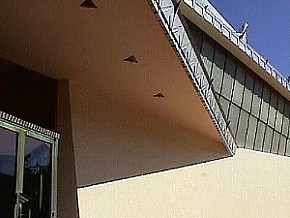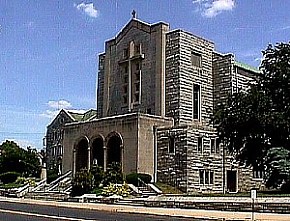2007.08.17
Temple University
2007.09.13
Quondam ideas
Fill in the Philadelphia Museum of Art (blank) plan with excerpts from other museum plans. Do this for three levels above ground, and also do a series of below ground plans (a la the new Gehry project/expansion). This will be the Museum within Ichnographia Quondam (along with Parkway Interpolation and the Bilocating Barnes and Calder Musuem).
Get the Mies Courthouse with Garage model executed... ...the model will be a fecund "play thing". ...a couple other Mies court houses...
...pages that organize the cad database collection into specific sets.
2007.10.02
Cut & Paste Museum 2386
2007.11.10 16:15
The End of Boxes
The Beginning of Boxes?

Louis I. Kahn, Norman Fisher House, construction completed June 1967.
2007.11.28
Duchamp Inn 2387
2007.11.30
Suburban Poché 2388
2007.12.04
Girard Collage 2389
| |
2008.03.07
Circle Squared Museum 2393
2008.06.25 14:23
Can you say canonical?
"Eisenman's Canon..."
Luigi Moretti, Casa "Il Girasole," 1947-50
Ludwig Mies van der Rohe, Farnsworth House, 1946-51
Le Corbusier, Palais des Congrès-Strasbourg, 1962-64
Louis I. Kahn, Adler & DeVore Houses, 1954-55
Robert Venturi, Vanna Venturi House, 1959-64
James Stirling, Leicester Engineering Building, 1959-63
Aldo Rossi, Cemetery of San Cataldo, 1971-78
Rem Koolhaas, Jussieu Libraries, 1992-93
Daniel Libeskind, Jewish Museum, 1989-1999
Frank O. Gehry, Peter B. Lewis Building, 1997-2002
2008.09.03
ideas
Cut & Paste Museum: create a model of all the composited models; a riff off Gehry's so far unpublished Philadelphia Museum of Art design.
2008.12.03 00:44
where is the good new architecture?
Is there really all that much difference between 31 December 1999 and 1 January 2000? They're arbitrary place setters, and not the demarcation of disticnt different times. Metaphorically, the calendar is the cart, not the horse.
Personally, I see the Seattle Library design going back to Kahn's [and Tyng's] mid-1950s Municipal Building designs for Philadelphia. Historical analysis within a space-time continuum is more ongoing productivity and less end-product.
2008.12.14 10:40
Shape and Form
Louis Sullivan's form follows function argued against architecture's form having become too removed from its function--banks shouldn't look like ancient temples; bankers don't wear togas. When Sullivan was in Philadelphia working at Frank Furness' office, 1872-73, it was on the same block as, if not right across the street from, William Strickland's Second Bank of the United States, with very severe Doric temple fronts, 1819-24. Strickland's Philadelphia architecture was meant to represent the United States as the new democracy, thus emulating (reenacting) the architecture of the old democracy of ancient Greece. Note, however, the similarity of the contemporaneous works of Strickland and Schinkel point to other factors also being present within the formulation of Strickland's style, likely the influence of the "Grand Durand".
| |
2008.12.31 09:38
pragmatists turning political?
brise-soleil: the politics of sun breaking
Le Corbusier, Museum of Knowledge
Kahn, Philadelphia Psychiatric
Venturi, Museum of Arts & Crafts
2009.01.25 11:21
Re: Philly Row House
...designing North Philadelphia as hyper-suburban. Versailles plus ultra even.
2009.01.31 16:38
Re: Misc. stuff
...a new way to think about Quondam--experiment with architecture within a/the space time continuum. For example, where some building models have already been collaged together, it's not just being playful but also seeing what it's like when architectures from different places and/or different times cross paths. Another example is how the Axis of Life of the Ichnographia matches the Benjamin Franklin Parkway is like where two different space/time architectures actually lock together, hence the Ichnographia Quondam.
2009.02.09 09:14
Re: Reenacting Paintings
Finally read the article, and yes it would have been more complete if the notion of reenactment was also addressed, as reenactment involves all the issues: reproduction, cloning, authenticity, degrees of separation, even, to some extent, space-time. I'd say the degrees of separation issue is here the most important in that, like you mention, the reproductions come extremely close to the original, and can even occupy the space of the original, but the reproductions can never be the original. I'm reminded of that aspect of calculus where the curve continues to more and more closely approach + or - 1 but never reaches the actual integer itself.
"Bifuracted authenticity" is an interesting notion, but, in terms of authenticity, it's a little misleading--there is still really only one authentic work (the reproduction Marriage of Cana even in original context is still a reproduction). Nonetheless, it brings to mind notions of the Baroque--"Within his double theater Bernini capsulized the beginning of Western culture's new bifurcation of the real and the illusory, introduced mirroring as a henceforth dominant (post) Baroque (stylistic) theme, and, at base (or should I say at the ultimate end), inverted reality into a reenactment of its own illusory mirror (--is this perhaps also the genesis of historiography?)." Plus, the mystical notion of bilocation, or is it actually something scientific as in the space-time continuum? Is the match of the Campo Marzio Axis of Life and the Benjamin Franklin Parkway an example of "bifurcated authenticity"?
So, generally, my take on the article is that 'reenactment' is missing and really should have been included. Greenaway essentially performed two reenactments--one the reenacted natural lighting in situ, and two the reenacted lighting on the reenacted painting at another/nearby site--and Factum Arte reenacted the Marriage of Cana at its original site.
Here a Versailles, There a Versailles, Everywhere a Versailles, sigh--going Baroque in the space-time continuum!
| |
2009.03.08
journal
Started the process of coordinating the Philadelphia model with Ichnographia Quondam. The priority is to bring each section up to the level of completeness a la the data existing thus far.
Employ Quondam as an outlet for architectural fiction, and, right now, the theme of Quondam's architecture fiction is Quondam itself...
2009.04.01
infrastructure architecture
"Philadelphia, the city within which I continue to live and work, was at that time also going through a infrastructural transition, particularly with regard to the beginning of the long awaited implementation of the planned cross-town Vine Street Expressway and it connection to Interstate 95. The new super-road, which is half sunken and half raised in the air, comprises massive retaining walls and great elevated ramps. For me, these enormous structures embodied a new urban monumentality, although I doubt many others shared the same impression.
There were indications, however, that I was not totally alone in my appreciation of "highway architecture" and its potential of holding a positive position within contemporary urban design."
Can one legitimately call Le Corbusier's Palais des Congrès, Stirling's Wallraf-Richartz Museum, and OMA's Library for Jussieu infrastructural architecture?
2009.04.07
IQ ideas
...placing the collection of Villa Savoye derivatives onto the Philadelphia grid just as the plans are currently situated within the collective database. ...a place within Ichnographia Quondam to position the various models, and in turn provide a (new) context for the models.
...place the Campo Marzio Garden of Satire (Horti Luciliani) permanently within the Philadelphia grid. The point being to acknowledge the 'garden of satire' as a distinct place within IQ, and to see how the placement effects further growth (of ideas).
...have the Campo Marzio plans seep into the blank footprints of Parkway Interpolation buildings, and then extrude the Campo Marzio fragments as solids and infill the remaining space with transparent surfaces. In this sense the Campo Marzio plans act as infrastructural base for further building design development.
...to further develop the notion of architecture museum and the notion of using museums. Using [the] museum (and IQ) as the place where the analysis as well as the design happens... ...the illustrations of ideas and analyses become places themselves. This last statement has a potentially profound implication regarding the whole notion of executing virtual place.
2009.07.07
bilocation, finally
Some more on "Bilocation Syndrome":
Axis of Life / Benjamin Franklin Parkway.
Diana the Huntress/Nympaeum; Vatican/Life of Constantine tapestries; Gates of Hell; Logan Circle/Hadrian's Tomb; Intercourse building/Love Park.
| |
2009.08.18 12:50
Postmodernism sucks... discuss
Does 'ad grand mosque' operate within a realm of no clear rules beyond the immediate context of the situation?
Religious architecture, almost by definition, operates within a realm where there are clear rules beyond the immediate context of the situation.
I'm reminded of Frank Lloyd Wright's Beth Sholom Synagogue (1954),


where there are clear uses of ornament, albeit a modern building.
Symbolism, too, continues to be an (almost innate) ingredient of religious architecture.

St. Helena Church, Olney, Philadelphia (1950).
According to legend, St. Helena, feast day 18 August, discovered the 'True Cross'.
|